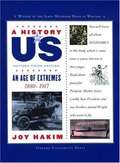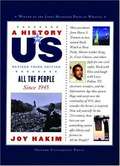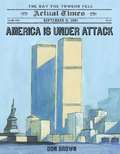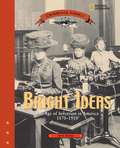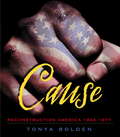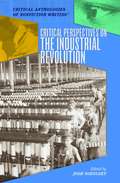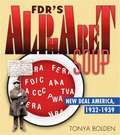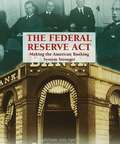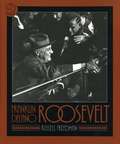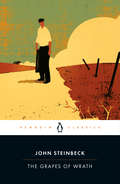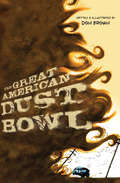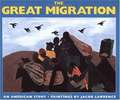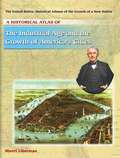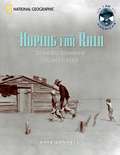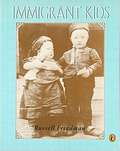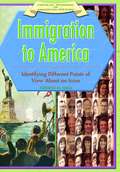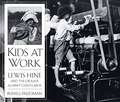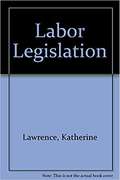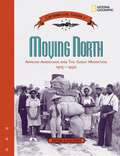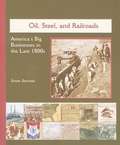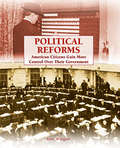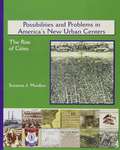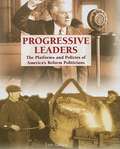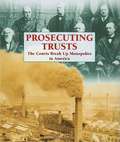Special Collections
District List: NYC Core Curriculum 8th - Social Studies
Description: The New York City Core Curriculum program aims to provide a high-quality curricula to NYC students through a seamless instructional program across grades and subjects. This list has been curated by #NYCDOE for 8th Grade Social Studies materials.
- Table View
- List View
An Age of Extremes
by Joy HakimFor the captains of industry men like Andrew Carnegie, John D. Rockefeller, J. P. Morgan, and Henry Ford, the Gilded Age was a time of big money. Technology boomed with the invention of trains, telephones, electric lights, harvesters, vacuum cleaners, and more. But for millions of immigrant workers, it was a time of big struggles, with adults and children alike working 12 to 14 hours a day under extreme, dangerous conditions. The disparity between the rich and the poor was dismaying, which prompted some people to action. In An Age of Extremes, you'll meet Mother Jones, Ida Tarbell, Big Bill Haywood, Sam Gompers, and other movers and shakers, and get swept up in the enthusiasm of Teddy Roosevelt. You'll also watch the United States take its greatest role on the world stage since the Revolution, as it enters the bloody battlefields of Europe in World War I. [This text is listed as an example that meets Common Core Standards in English language arts in grades 4-5 at http://www.corestandards.org.]
All the People
by Joy HakimPeople call it "post-war," but All the People covers a period in U.S. history that features battles of another kind-- from Cold War combat overseas to struggles for equality at home to learning to live with the threat of terrorism on U.S. soil. During these years, the United States began to be a nation for all its people, outlawing school segregation, protesting war in Vietnam, and campaigning for equal rights for women. From Supreme Court Justice Thurgood Marshall to seamstress Rosa Parks, extraordinary individuals led us back to the ideals espoused by the Declaration of Independence, the Constitution, and the Bill of Rights. But mostly-- as it always has been in the United States-- it was ordinary citizens who marched and voted and hoped and dreamed and made things happen. All the People includes the events of September 11, 2001, and a discussion of how many aspects of the terrorist attacks have brought to the forefront the qualities that keep America strong: representative democracy, freedom of speech and press, and, especially in the face of religious totalitarianism, the basic freedom of religious tolerance. [This text is listed as an example that meets Common Core Standards in English language arts in grades 4-5 at http://www.corestandards.org.]
America is Under Attack
by Don BrownOn the ten year anniversary of the September 11 tragedy, a straightforward and sensitive book for a generation of readers too young to remember that terrible day.
The events of September 11, 2001 changed the world forever. In the fourth installment of the Actual Times series, Don Brown narrates the events of the day in a way that is both accessible and understandable for young readers.
Straightforward and honest, this account moves chronologically through the morning, from the terrorist's plane hijackings to the crashes at the World Trade Center, the Pentagon, and Pennsylvania; from the rescue operations at the WTC site in New York City to the collapse of the buildings.
Bright Ideas
by Ann RossiImagine that you couldn't turn on a light by flipping a switch, had no telephone on which to call your friends, and that there were no traffic lights on the roads! Seem impossible? Well it wasn't-none of these things existed before the Age of Invention in the late 19th and early 20th centuries.
Bright Ideas tells the story of these and other miraculous inventions that have shaped the world we know today. Learn how inventive minds work and how they overcame obstacles on the path to their great achievements.
Read about the building of a brighter America-one that learned how to make a telephone call from coast to coast and took to the road in Henry Ford's cars built on the first assembly lines. Even flying in the air became attainable! This age and the inventors who contributed to it paved the way for the future of America and revolutionized the way this country works, produces, and lives.
Bright Ideas illuminates this exciting period in time for all its readers and may inspire even greater inventions or future inventors. Like the others in the series, ,Bright Ideas is illustrated with period photographs, paintings, and drawings. Also included are a glossary and an index.
Cause
by Tonya BoldenAfter the destruction of the Civil War, the United States faced the immense challenge of rebuilding a ravaged South and incorporating millions of freed slaves into the life of the nation. On April 11, 1865, President Lincoln introduced his plan for reconstruction, warning that the coming years would be "fraught with great difficulty." Three days later he was assassinated. The years to come witnessed a time of complex and controversial change.From the Hardcover edition.
Critical Perspectives On The Industrial Revolution
by Josh SakolskyAs modern man's greatest growth spurt, the Industrial Revolution ushered in an era unsurpassed in the history of the modern world, from technology to industry to migration. Using an eclectic group of viewpoints including presidential addresses, anonymous testimony, and the perspectives of such figures as Jack London, H.G. Wells, and Henry Ford, this title seeks to understand the scope, origin, and effects of the Industrial Revolution. The reader is drawn into a time and place that is still affecting the world today.
Ellis Island
by William Jay JacobsAn inspiring chronicle of the immigrant experience recounts the history of Ellis Island from 1892 to 1954, the period during which more than seventeen million immigrants passed through its doors in search of new lives in America.
FDR's Alphabet Soup
by Tonya BoldenFDR’S New Deal, which followed the 1929 stock market crash, was a hugely influential moment in the history of the United States, encompassing everything from the arts to finance, labor to legislation, and some think it helped bring the country out of the Great Depression. Here, Tonya Bolden, writing in her trademark accessible style, creates a portrait of a time that changed American history both then and now.
FDR’s First 100 Days and how the United States was changed by it then are closely examined, especially now. The 2009 financial situation is eerily mirrored by that of the late 1920s, and this is a perfect book to help teens understand history and its lasting impact on current events.
The Federal Reserve Act
by Melanie Ann ApelThe American banking system after the Civil War was not centralized but rather functioned independently in different geographical areas. Policies were not coordinated to insure that the money supply was sufficient to keep governments and businesses running properly. Through the efforts of the progressives, the Federal Reserve Act was passed to devise and implement a plan to stave off problems in currency, policies, and the money supply.
Franklin Delano Roosevelt
by Russell Freedman"As in Lincoln: A Photobiography (Clarion, 1987), Freedman has taken a larger-than-life historical figure about whom innumerable volumes have been written and has retold the story of one man's life in the context of his times. The carefully researched, highly readable text and extremely effective coordination of black-and-white photographs chronicle Roosevelt's priviledged youth, his early influences, and his maturation. Drawing on first-hand observations of his family, friends, and enemies, as well as Roosevelt's own diary entries, Freedman formulates a composite picture of a complex, enigmatic individual and a consummate politician. Roosevelt's public career is given further significance because of the cataclysmic events of the Depression and the tumultuous war years during his presidency. As controversial as many of his programs and policies were or have come to be, no one could ever call to question his dedication, his initiative, or the energy he brought to the job. His all too human shortcomings are just as clearly delineated. Even students with little or no background in American history will find this an intriguing and inspirational human portrait."
-School Library Journal
The Grapes of Wrath
by John Steinbeck and Robert DemottThe Pulitzer Prize-winning epic of the Great Depression, a book that galvanized--and sometimes outraged--millions of readers.
First published in 1939, Steinbeck's Pulitzer Prize-winning epic of the Great Depression chronicles the Dust Bowl migration of the 1930s and tells the story of one Oklahoma farm family, the Joads-driven from their homestead and forced to travel west to the promised land of California. Out of their trials and their repeated collisions against the hard realities of an America divided into Haves and Have-Nots evolves a drama that is intensely human yet majestic in its scale and moral vision, elemental yet plainspoken, tragic but ultimately stirring in its human dignity.
A portrait of the conflict between the powerful and the powerless, of one man's fierce reaction to injustice, and of one woman's stoical strength, the novel captures the horrors of the Great Depression and probes into the very nature of equality and justice in America.
The Grapes of Wrath summed up its era in the way that Uncle Tom's Cabin summed up the years of slavery before the Civil War. Sensitive to fascist and communist criticism, Steinbeck insisted that "The Battle Hymn of the Republic" be printed in its entirety in the first edition of the book--which takes its title from the first verse: "He is trampling out the vintage where the grapes of wrath are stored." At once a naturalistic epic, captivity narrative, road novel, and transcendental gospel, Steinbeck's powerful landmark novel is perhaps the most American of American Classics.
This edition contains an introduction and notes by Steinbeck scholar Robert Demott.
The Great American Dust Bowl
by Don BrownA speck of dust is a tiny thing. In fact, five of them could fit into the period at the end of this sentence.On a clear, warm Sunday, April 14, 1935, a wild wind whipped up millions upon millions of these specks of dust to form a duster—a savage storm—on America's high southern plains. The sky turned black, sand-filled winds scoured the paint off houses and cars, trains derailed, and electricity coursed through the air. Sand and dirt fell like snow—people got lost in the gloom and suffocated . . . and that was just the beginning.Don Brown brings the Dirty Thirties to life with kinetic, highly saturated, and lively artwork in this graphic novel of one of America's most catastrophic natural events: the Dust Bowl.
The Great Migration
by Jacob LawrenceA series of paintings chronicles the journey of African Americans who, like the artist's family, left the rural South in the early twentieth century to find a better life in the industrial North.
A Historical Atlas Of The Industrial Age And The Growth Of America's Cities
by Sherri LibermanHere is an exquisite portrait of America and its people during the Industrial Revolution. Important events are discussed, including late developments in the American West, the abuse of power by big business, the changes in social attitudes, and the emergence of workers rights and a middle class.
Using maps and primary source images, the easy-to-understand text focuses on the principal activists of the Progressive movement and the reforms that were made between 1900 and 1920.
Hoping for Rain
by Kate ConnellLike many farmers living in the Great Plains during the 1930s, the Bucklers are ravaged by months of dust storms and drought. Out of desperation, they travel West with their children, Patty and Earl, in hopes of finding new prosperity. Through letters and diary entries written by the Buckler children, readers witness the disaster of the Dust Bowl and the countless days spent wishing for an end to the drought - and their hunger. As they travel across the country, young Earl searches for work so he can help provide for the family. using the children's first-person accounts as well as period illustrations and photographs, the book accurately depicts the devastating effects of the Dust Bowl in the 1930s and '40s.
Immigrant Kids
by Russell FreedmanText and period photographs chronicle the life of immigrant children at home, school, work, and play during the late 1800s and early 1900s.
Immigration To America
by Therese SheaThe integration of narrative and various drills prompts students to learn about different points of view concerning immigration to America. This book discusses the earliest immigrants to America, how different people might have viewed certain documents and historical events differently, and why each immigrant group traveled to the United States to make it its new home.
Kids at Work
by Russell FreedmanLewis Hine's photographs expose the chilling reality of the inhumane working conditions American children endured during the early twentieth century. Hines's photographs of children at work were so devastating that they convinced the American people that Congress must pass child labor laws.
Labor Legislation
by Katherine LawrenceThis book provides a look at the hardships of American labor and how immigrants working for low pay and in hazardous conditions reaped few benefits. The labor movement found a champion in President Roosevelt, who paved the way for significant government regulation of American industry. Through manageable text enhanced by period illustrations, Labor Legislation documents the moments that led to labor laws and the implementation of major reforms for workers.
Moving North
by Monica HalpernAfter the Civil War, the South went through a period of rebuilding, termed Recon-struction, but because many white people in the South were not ready to accept African Americans as equals, unfair laws were passed which restricted the rights of blacks. These Black Codes and Jim Crow laws left African Americans adrift in a segregated world.
Life was better in the North in many ways for African Americans. The 1920s brought jobs and money—until The Great Depression hit. The Depression left many homeless and jobless. Many blacks left the cities seeking jobs wherever they could find them. Despite the hard times that followed, living in the North continued to bring a renewed sense of freedom to many African Americans.
Oil, Steel, and Railroads
by Jesse JarnowExamines the history of business in the United States during the 1800s, discussing the growth of railroads, and the innovations in the oil and steel industries.
Political Reforms
by Katherine WingateAmerica's industrial revolution revealed the close ties between big business and the government that allowed a select few to gain power and riches over those struggling to make a living. The progressives believed the only way to empower disenfranchised individuals was to reform the political process. Here Wingate describes the initiatives taken by the progressives to force local and state legislatures to allow more political power to the people rather than government and business.
Possibilities and Problems in America's New Urban Centers
by Suzanne J. MurdicoDiscusses the problems faced in the cities during the Industrial Revoultion, including over-crowding, poor working conditions, and low wages.
Progressive Leaders
by Lois SakanyStudents will gain an understanding and appreciation of the most important people who defined the Progressive Era: the Great Commoner William Jennings Bryan, Senator Robert La Follete and his liberal politics, Theodore Roosevelt and his Square Deal Policy, and Woodrow Wilson and the establishment of the Federal Trade Commission. This title will reinforce one view that the progressive accomplishments left a positive impact on society, while the other view is that they gave too much power and responsibility to government.
Prosecuting Trusts
by Bernadette BrexelBig business in the mid-1800s worked to eliminate competition by purchasing smaller businesses or undercutting their prices. They created trusts, or groups of businesses under one giant merging corporation, affecting both small businesses and farmers. As this book effectively addresses, there were calls for business reform by the 1890s. Laws like the Sherman Antitrust Act sought to redress the problems of big business, but it was through the efforts of President Theodore Roosevelt that the federal government went after these trusts; those actions earned Roosevelt the reputation as a trust buster.
